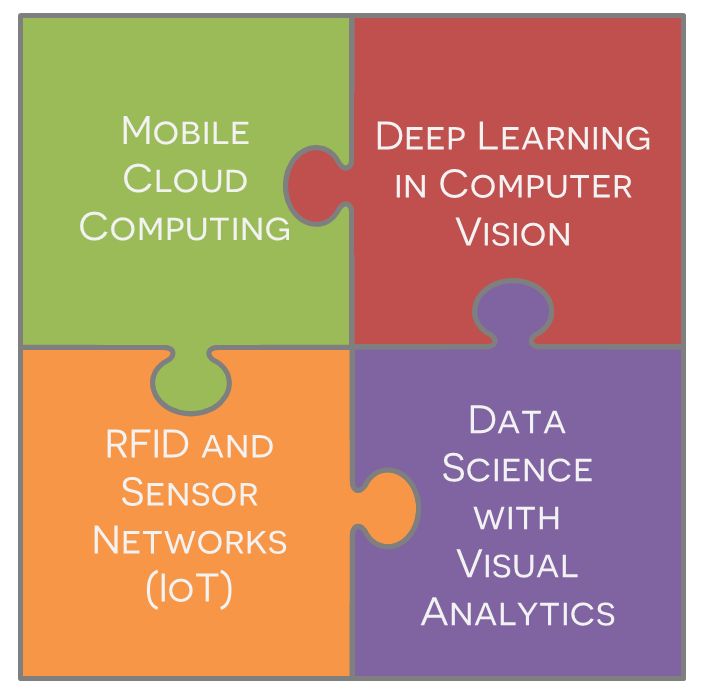
|
|
|
|
|
|
|

|
|
|
|
|
|
|
This workshop organized by the Computer Science Department at SUNY Korea brings together faculty from Stony Brook University, NY, and graduate and undergraduate students from SUNY Korea, POSTECH University, and Yonsei University supported by the MSIP (Ministry of Science, ICT and Future Planning) “ICT Consilience Creative Program". The date of the workshop is July 13-17, 2015.
Course topics:
RFID and Sensor Networks
This lecture will cover key enablers of future Internet of Things (IoT) — tiny devices that communicate with the infrastructure or with one another using very little power. These devices may communicate their identification or data from on-board sensors and may perform minor computations depending on the application. Examples include future incarnations of RFID and sensor networks. Such networks depart from conventional computer networks in that these devices are extremely resource constrained and may rely completely on harvested power. We will cover network protocol design and related systems issues for such systems. Specific focus will be on backscatter radios that can communicate without active power source, principles of multihop relaying in low-power context, design of publish-subscribe systems, and principles of radio-based localization.
Data Science with Visual Analytics
Data science is a mixture between visualization, statistics, applied mathematics, data management, AI, machine learning) and the fields that need to employ these methodologies to drive discovery (the biological sciences, the environmental sciences, the physical sciences, the social sciences, and beyond). It relies on new methods, new tools, new partnerships, and new types of people. Visualization is an integral part of data science, and essential to enable sophisticated analysis of data. This tutorial will discuss how visual analytics techniques can help in data science problems. We will discuss visual representations and interaction techniques that take advantage of the human eye's broad bandwidth pathway into the mind to allow users to see, explore, and understand large amounts of information at once.
Deep Learning in Computer Vision
Extracting high-level representations from visual data is a core task in Computer Vision. In the last few years, since the success of deep (hierarchical) models that are capable of extracting useful, high-level structured representations in visual object recognition, the application of Deep Learning methods has been transforming the field.. We will explore graphical models and deep learning models to include: (1) Unsupervised learning methods, including autoencoders, de-noising autoencoders, restricted Boltzmann machines, stacked restricted Boltzmann machines, sparse coding, and methods for learning over-complete representations; (2) Supervised methods for deep models, including deep convolutional models and their applications to image and video analysis; (3) More advanced models, including Deep Boltzmann Machines and Deep Belief Networks. We will also address mathematical issues, focusing on efficient large-scale optimization methods for inference and learning
Mobile Cloud Computing
In this tutorial, first we will present the general architecture of Mobile Cloud Computing platforms. Before the advent of smartphones, researchers had explored the possibility of offloading computation from resource constrained mobile devices under the name of cyber foraging. After the advent of smartphones, the concepts of cyber foraging were reinvented and often architected afresh by keeping in mind the challenges posed by the diverse and ever increasing workload on the smartphones. We will cover the Mobile Cloud Computing architectures that were the result of the initial investigations. In the second part of the tutorial, we will focus on the effects of uncertain operating environment on the benefits of Mobile Cloud Computing. We will present the techniques to operate successfully in varying environments. Since there are many variable parameters, the problem is challenging and still poses many open questions. Finally, we will show how specific applications can benefit from the use of Mobile Cloud Computing paradigm. In this part, we will focus on cloud based mobile gaming to highlight how Mobile Cloud Computing platform can be useful in pushing the boundaries of mobile gaming.
The workshop was supported by the MSIP (Ministry of Science, ICT and Future Planning), Korea, under the “ICT Consilience Creative Program” (IITP-2015-R0346-15-1007) Supervised by “IITP (Institute for Information & Communications Technology Promotion)"